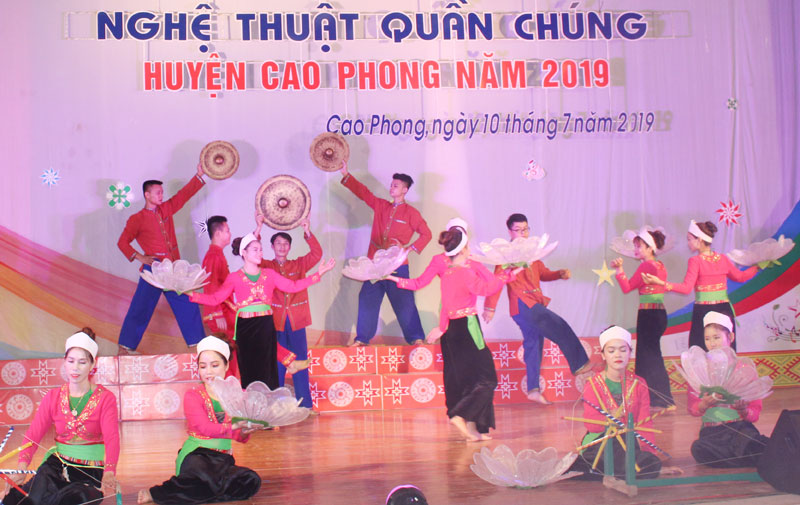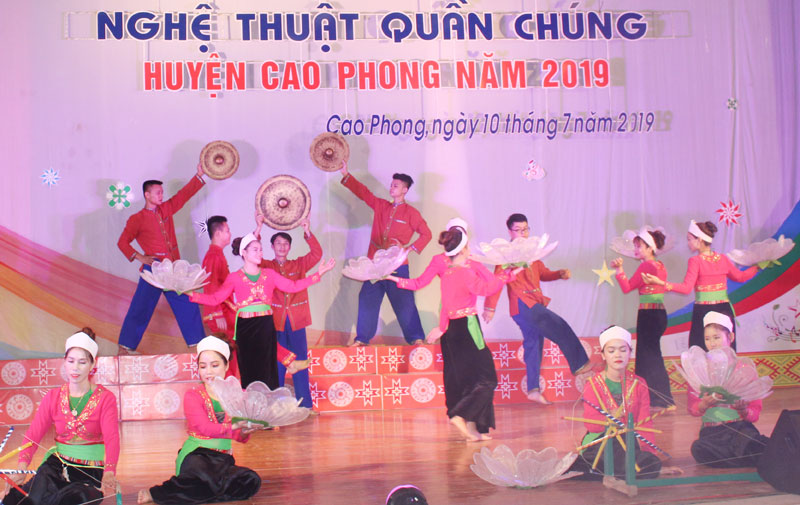
(HBO) - The festival of the public performance in Cao Phong district in 2019 has really become a festival of the actors, the artisans and the people of Cao Phong district. With over 60 featured songs, dances and music performed by the public performing arts teams, the festival has brought a rich colorful picture, introducing the special local culture and has left a lot of emotions for the viewers.
 The dancing performance "The beauty and flavor of Thang
Muong" by Bac Phong commune at the festival of the public performance in
Cao Phong district in 2019.
The dancing performance "The beauty and flavor of Thang
Muong" by Bac Phong commune at the festival of the public performance in
Cao Phong district in 2019.
Mr. Bui Van Hung, the Deputy Director of Cao Phong Center
for Culture, Sports and Information, says that this festival of the public
performance has been highly appreciated in terms of quality and quantity. The
mass cultural movement in the district has been maintained and increasingly
developed, spreading and attracting a large number of people to participate.
The quality of the movement has also been improved. The content of activities
of the performing arts teams at the grassroots is folk songs, folk dance,
traditional musical instruments, traditional costumes and so on. This is a
factor contributing to preserving the traditional beauty and the cultural
identity of the nation.
Currently, 100% of the villages, the hamlets and the
residential areas have performing arts teams, each team has from 20 to 30
members. Every year, besides the competitions and the performances of the
public performance, the propaganda are held periodically and the localities,
the agencies, schools also organize many competitions, performances, festivals
of arts performances associated with the great holidays, the great local events
of the localities and units with a wide variety of topics.
The members of the public performing arts teams are also
active propagandists in propagating the guidelines of the Party, the policies
and the laws of the State, contributing to the prevention and control of the
social evils and building a cultural life at the grassroots level.
With an increasingly vibrant and widespread emulation movement aimed at building cultured residential areas and cultured families, Yen Thuy District has been making steady progress toward improving both the material and spiritual well-being of its people, while fostering a civilized, prosperous, beautiful, and progressive community.
Once lacking recreational spaces and community facilities, Residential Group 2 in Quynh Lam Ward (Hoa Binh City) has recently received attention for the construction of a new, spacious, and fully equipped cultural house. The project followed the model of state support combined with public contributions in both labor and funding.
The "All people unite to build cultural life" movement, which has been effectively integrated with Kim Boi district’s socio-economic development goals, is fostering a lively spirit of emulation across local residential areas, hamlets, villages, public agencies, and enterprises. In addition, through the initiative, traditional cultural values are being preserved and promoted, while community solidarity and mutual support in poverty reduction and economic development are being strengthened.
A working delegation of the Hoa Binh provincial People’s Committee led by its Permanent Vice Chairman Nguyen Van Toan on June 11 inspected the progress of a project to build the Mo Muong Cultural Heritage Conservation Space linked to tourism services in Hop Phong commune, Cao Phong district.
Born and growing in the heroic land of Muong Dong, Dinh Thi Kieu Dung, a resident in Bo town of Kim Boi district, in her childhood was nurtured by the sweet lullabies of her grandmother and mother. These melodies deeply imprinted on her soul, becoming an inseparable part of her love for her ethnic group's culture. For over 20 years, this love for her hometown has driven Dung to research, collect, and pass down the cultural values of the Muong people to future generations.
In the final days of May, the Ethnic Art Troupe of Hoa Binh Province organized performances to serve the people in remote, mountainous, and particularly disadvantaged areas within the province. These were not just ordinary artistic shows, but they were the meaningful journeys aimed at spreading cultural values, enhancing the spiritual life of the people and contributing to the preservation of ethnic minority cultural identities.



 The dancing performance "The beauty and flavor of Thang
Muong" by Bac Phong commune at the festival of the public performance in
Cao Phong district in 2019.
The dancing performance "The beauty and flavor of Thang
Muong" by Bac Phong commune at the festival of the public performance in
Cao Phong district in 2019.